
The oilbird, locally known as the guácharo, is a bird species found in the northern areas of South America including the Caribbean island of Trinidad. It is the only species in the genus Steatornis, the family Steatornithidae, and the order Steatornithiformes. Nesting in colonies in caves, oilbirds are nocturnal feeders on the fruits of the oil palm and tropical laurels. They are the only nocturnal flying fruit-eating birds in the world. They forage at night, with specially adapted eyesight. However, they navigate by echolocation in the same way as bats, one of the few birds to do so. They produce a high-pitched clicking sound of around 2 kHz that is audible to humans.
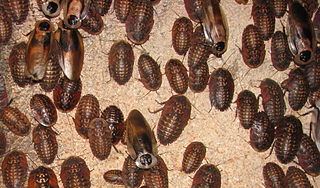
Giant cockroaches, or blaberids, are the second-largest cockroach family by number of species. Mostly distributed in warmer climates worldwide, this family is based on the American genus Blaberus, but much of the diversity is also found in Africa and Asia.
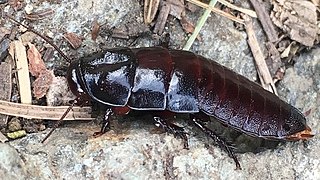
Cryptocercus is a genus of Dictyoptera and the sole member of its own family Cryptocercidae. Species are known as wood roaches or brown-hooded cockroaches. These roaches are subsocial, their young requiring considerable parental interaction. They also share wood-digesting gut bacteria types with wood-eating termites, and are therefore seen as evidence of a close genetic relationship, that termites are essentially evolved from social cockroaches.

The smokybrown cockroach is a large species of cockroach, winged, and growing to a length of 32–35 millimetres (1.3–1.4 in).

Blattodea is an order of insects that contains cockroaches and termites. Formerly, termites were considered a separate order, Isoptera, but genetic and molecular evidence suggests they evolved from within the cockroach lineage, cladistically making them cockroaches as well. The Blattodea and the mantis are now all considered part of the superorder Dictyoptera. Blattodea includes approximately 4,400 species of cockroach in almost 500 genera, and about 3,000 species of termite in around 300 genera.

Cockroaches are insects belonging to the order Blattodea (Blattaria). About 30 cockroach species out of 4,600 are associated with human habitats. Some species are well-known as pests.

The giant burrowing cockroach is also known as the rhinoceros cockroach, and Queensland giant cockroach. These cockroaches are native to Australia and mostly found in tropical and subtropical parts of Queensland. They are the world's heaviest species of cockroach and can weigh up to 30-35 grams and measure up to 7.5-8 cm (3.1 in) in length. It is a member of the family Blaberidae, which contains hundreds of species. It is part of the blaberid subfamily Geoscapheinae. It is prominent in the wild and can also be sold and kept as a pet.
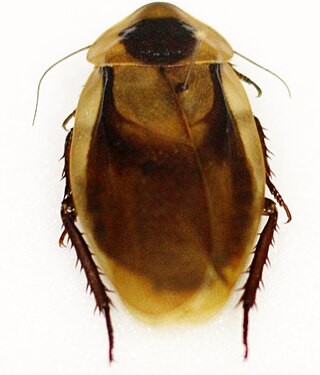
Blaberus discoidalis, commonly known as the discoid cockroach, tropical cockroach, West Indian leaf cockroach, false death's head cockroach, Haitian cockroach, and drummer, is a cockroach native to Central America of the “giant cockroach” family, Blaberidae.

The death's head cockroach is a species of cockroach belonging to the family Blaberidae. It is often confused with the discoid cockroach, Blaberus discoidalis, due to its similar appearance. It is distinguished by jet black cloak-like marking on its wings and a skull-shaped, amber/black marking on its pronotum. The name death's head comes from the markings on the top of the pronotum: "cranii", which is Latin for "of the head", and "fer", meaning "carry" or "carrier". Due to their unique appearance and certain characteristics, they make an easy to care for pet or display insect for entomologists and hobbyists.
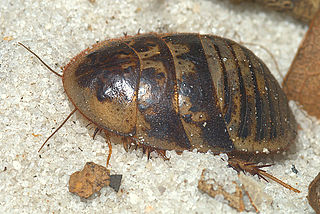
Arenivaga is a genus of sand cockroaches, of the subfamily Corydiinae, in the family Corydiidae. These cockroaches live in sandy soils and dunes in the southwestern United States, Florida and Mexico. Arenivaga comes from the Latin arena meaning sand and vagus meaning wandering.

Blaberus giganteus, the Central American giant cave cockroach or Brazilian cockroach, is a cockroach belonging to the family Blaberidae. One of the world's largest cockroaches, it is native to the warm parts of the Neotropical realm.
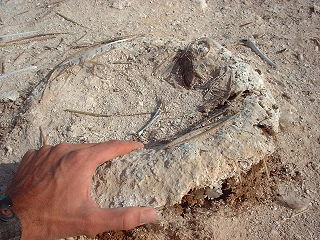
Guano is the accumulated excrement of seabirds or bats. Guano is a highly effective fertilizer due to the high content of nitrogen, phosphate, and potassium, all key nutrients essential for plant growth. Guano was also, to a lesser extent, sought for the production of gunpowder and other explosive materials.

Blaptica dubia, the dubia roach, orange-spotted roach, Guyana spotted roach, or Argentinian wood roach, is a medium-sized species of cockroach which grows to around 40–45 mm (1.6–1.8 in).

Therea petiveriana, variously called the desert cockroach, seven-spotted cockroach, or Indian domino cockroach, is a species of crepuscular cockroach found in India and Sri Lanka. They are members of a basal group within the cockroaches. This somewhat roundish and contrastingly marked cockroach is mainly found on the ground in scrub forest habitats where they may burrow under leaf litter or loose soil during the heat of the day.

The Turkestan cockroach, also known as the rusty red cockroach, red runner cockroach or simply rusty red, red runner, or lat, is a primarily outdoor-dwelling cockroach native to an area from northern Africa to Central Asia. Adults measure around 3 cm (1.2 in) in length. Adult males are a brownish orange or red, are slender, and have long, yellowish wings which allow it to attract females and to glide. Adult females are dark brown to black, with cream-colored markings on the shield and a cream-colored stripe edging its wings; they are broader than males, and have short vestigial wings. Nymphs are brown in front, black on the rear, and are wingless.

Eublaberus is a genus of South American cockroaches in the subfamily Blaberinae, erected by Morgan Hebard in 1920.
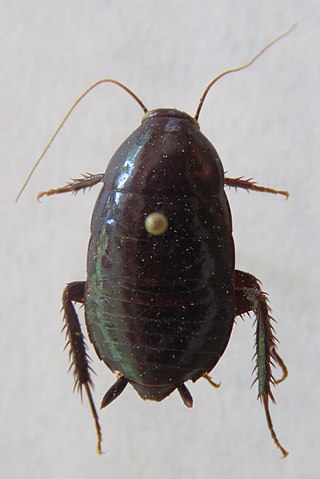
Lamproblattidae is a small family of South and Central American cockroaches in the order Blattodea. It consists of three genera and 10 species:
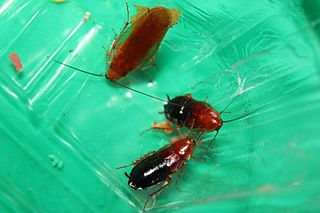
Parcoblatta caudelli, Caudell's wood cockroach or Caudell's wood roach, is a species of cockroach native to the United States.

Lucihormetica verrucosa is a species of giant cockroach in the family Blaberidae, commonly known as the warty glowspot cockroach. It is native to Venezuela and Colombia.

Megaloblatta is a genus of Neotropical cockroaches in the family Ectobiidae. Species in this genus are 4 to 9.7 cm (1.6–3.8 in) long and can have a wingspan of up to 20 cm (8 in); the world's largest cockroach by length and wingspan is M. longipennis.






















